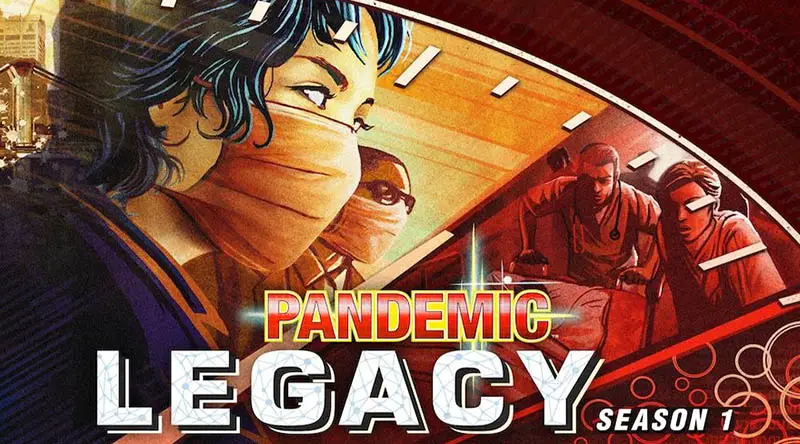
The world is falling apart. Four diseases are sweeping the planet and your team is on the front lines. Worse yet, one disease has shown signs that it may become resistant to any treatment.
Pandemic Legacy is a cooperative game where all players must work together to develop cures and prevent disease outbreaks, before 4 diseases contaminate humanity. You will all win or lose together.
Can you survive the year and save humanity?
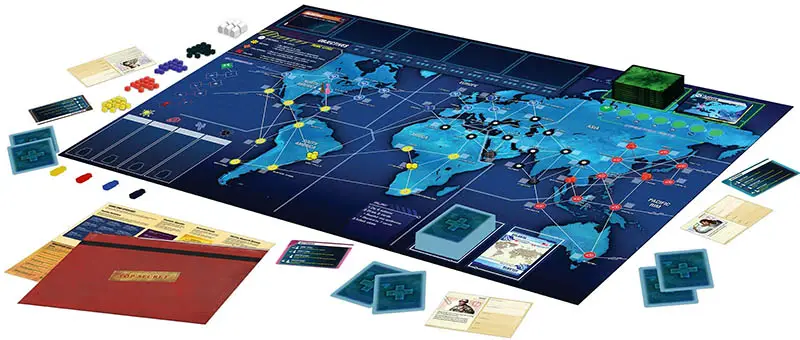
Components
- 1 Board
- 5 Character cards
- 4 Pawns
- 61 Player cards (48 City cards, 5 Epidemic cards, 8 Event cards)
- 4 Reference cards (one per player color)
- 48 Infection cards
- 62 Legacy cards
- 4 Civilian cards
- 5 Dossiers and 1 Sticker sheet
- 1nfection rate marker
- 4 Cure markers
- 1 Reminder token
- 1 Outbreaks marker
- 96 Disease cubes
- 6 Research stations
Overview

Unlike most games, which fully reset every time you play, Pandemic Legacy carries some elements forward from one game to the next. Decisions you make in game 1 will be there in game 2,3, and every game played with your copy of the game.
Different groups will make different decisions and will have a different experience. What results is a game unique to the group that plays it.
Sometimes you will write on parts of the game. Sometimes you will put stickers on cards or the board. Sometimes you will even destroy (tear up) a card. These changes are permanent.
Also, at the end of each game, the group will make two Game End Upgrades to prepare for future games. You will put stickers on the board, cards, and character.
As you play, you will learn about other ways the game will change.
Also, some elements of play are hidden and sealed off before your very first game. As you play, you will find instructions that tell you when to open these packages. Do not open the packages in the box until you receive instructions to do so. The dossiers also contain hidden information that will be revealed as you play.
Some rules, labeled A through Y, are missing throughout these rules. As you play, you will gain these missing rules. From that point on, the rules will be permanently changed.
If You've Never Played Pandemic...
We recommend that you play a few games without any of the special "Legacy" rules to get a feel for the decisions you will have to make.
Read these rules then play without using the following rules:
- Game Months, Legacy Deck, Dossiers
- Objectives, Funding, Game Calendar, Panic Level
- Scars and Lost Characters
- Game End Upgrades
The object of these warm-up games is to cure four diseases before any of the game-losing conditions are triggered. You should play at least two games this way to get a feel for the game before adding the additional rules.
What Stays And What Gets Reset?
Writing on the board, putting stickers on the board or on cards, and possibly tearing up or destroying components are permanent changes.
In all other ways, the game resets for the start of each game. The pieces on the board, cards in hand, outbreaks, etc. all start fresh.
Game Months
Pandemic Legacy is broken into 12 months, starting with January.
If your group succeeds in a month, you move on to play the next month. If you fail, you get one more chance to succeed in the current month. Start a new game with the current set of rules and objectives for the month you just lost. If you lose again, you must move on to the next month for your next game.
The Legacy Deck
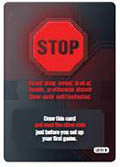
The Legacy Deck contains cards that will describe what happens over the course of the game's 12 months. It is arranged in a specific order-do not look through or shuffle these cards. At the start of a game, draw the cards and read them one at a time, until you get to a card that says STOP on the back.
This card will tell you when to continue drawing from the deck, which might be mid-game, at the end of a game, or at the start of the next month. The Legacy Deck is a one-way trip. Even if you repeat a month, do not put Legacy cards back.
The tray was designed with two spaces for used Legacy cards: one for the used cards, the other for cards that will be used in future games.

If the Legacy Deck becomes scattered, have someone who is not playing the game put the cards back in order using the numbers in the corner of each card. Shown to the right is the first Legacy Deck card (LD 01 B).
To ensure this does not happen, once you've removed it from its packaging, leave the Legacy Deck in the storing tray.
The Dossiers
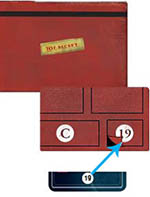
The five dossiers contain the stickers that will go onto the game. As you go through the Legacy Deck, you will come across cards that have dossier numbers or letters on them.
When you do, open up - and tear off using the precut corner - the dossier doors matching the numbers (or letters) on the card, one at a time, resolving each one before opening the next.
Some of these dossier doors will contain one-time stickers. Others will create a card that will be used from time to time in future games.
The Packages
There are eight packages in the game. As you play through the game, yellow boxes will instruct you to open specific packages.
Important: Before your very first game, place the Open Package 8 sticker on door 8 of the package box, in the frame designed for it.
Objectives
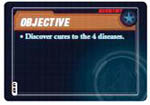
At the beginning of each game, you will have an objective (or objectives) you need to complete in order to win. The number of objectives needed to win in a month is shown on the board for that month.

If an objective is marked as mandatory, it must be completed in order to win. You do not need to decide which other objectives you are trying to accomplish at the beginning of any game; you may wait to see how the game unfolds.
Some objectives will remain in play until the group completes them; others will expire at the end of a particular month. As the year unfolds, new objectives will be introduced.
Funding
At the beginning of each game, you will add Funded Event cards (of the group's choice) to the Player Deck equal to your Funding Level. Your Funding Level is 4 at the beginning of the first game in January but will go up and down from game to game. The minimum funding is 0 and the maximum is 10.
Game Calendar
Use the game calendar to record your progress, wins and losses, players involved, and your current Funding Level. The game calendar can be found on the back cover of the rulebook.
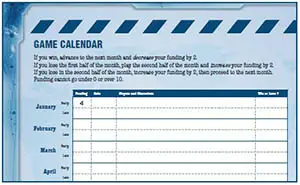
Reminder Token 
This token is used occasionally during games to remind players to remember something.
The Game Board
Regions
The board is broken up into six regions, each roughly equivalent to a continent. These will come into play later.
Objectives Section
In one corner of the board is a section where objectives are placed. January will start with one objective. Other objectives will be added and removed in future months.
Disease Tracking Area
Use this area of the board to apply changes to any of the four diseases.
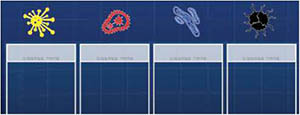
Panic Level
Cities are panicking as these diseases take hold. Whenever an outbreak occurs in a city, its panic level will go up by one. The first time a city panics, place the level 1 sticker (unstable) in the panic level sticker box near the city.
After that, place the next numbered sticker over the previous one (level 2, then level 3, etc).. The effects of panic levels are shown below. These effects are cumulative.
| Level | State | Effect |
|---|---|---|
 | Unstable | No effect. |
 | Rioting | Players cannot take Direct Flights or Charter Flights in or out. Research stations are destroyed and cannot be rebuilt. |
 | Collapsing | Discard 1 card of the city's color to enter this city with the Drive/Ferry action. |
 | Fallen | Discard an additional card of the city's color to enter this city with the Drive/Ferry action (for a total of 2 cards). If your character is in a city when it falls, it is lost. See |
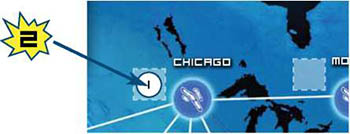
By placing the level 2 panic level sticker, the city's panic level goes from unstable to rioting.
Characters
Each player has a specific character with special abilities to improve the team's chances. Each player begins game 1 by creating a character.
To create a character: Select a Character card (each one has different special abilities) and give your character a name.

These characters will carry through from game to game and they may become lost (see below). You do not have to play the same character in every game.
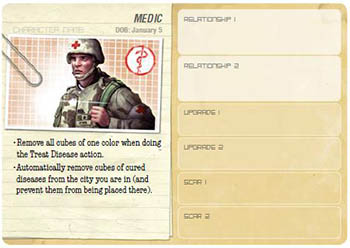
Scars
Characters can be mentally or physically damaged over the course of play. When this happens, choose an available scar and add it to your character's card. Characters are scarred when they are in a city that outbreaks and may be scarred in other ways that will be noted in future rules.
Whenever you must place a scar on a character that has no room for it, that character becomes lost.
Lost Characters
If you have to put a scar on your character and it has no more scar slots or if your character is in a city when it falls, your character is lost.
When your character is lost, destroy (rip up) your Character card. It cannot be played in this or in future games. Discard all cards you have, take the Civilian card matching your pawn, and place your pawn in a city with a research station (this may be your current city).
If there are no research stations in play, place your pawn in Atlanta. If your character was lost during your turn, continue with your turn, keeping any remaining actions you have.
Character Reference
Refer to this section after you've learned how to play the game for fine points regarding each of the characters.
Dispatcher

The Dispatcher may, as an action, either:
- move any pawn, if its owner agrees, to any city containing another pawn, or
- move another player's pawn, if its owner agrees, as if it were his own.
The Dispatcher can only move other players' pawns; he may not direct them to do other actions, such as Treat Disease.
When the Dispatcher moves a player's pawn as if it were his own:
- use the Dispatcher's scars and upgrades, not those belonging to the character he is moving,
- cards that need to be played or discarded (for Direct and Charter Flights or to enter a collapsing or fallen city) come from the Dispatcher's hand. A card discarded for a Charter Flight must match the city the pawn is moving from.

Generalist
The Generalist has slots for 4 different character upgrades and gets 5 actions per turn.
Medic

The Medic removes all cubes, not 1, of the same color when doing the Treat Disease action.
If a disease has been cured, he automatically removes all cubes of that color from a city, simply by entering it or being there. This does not take an action.
The Medic also prevents placing disease cubes (and outbreaks) of cured diseases in his location. The Medic's automatic removal of cubes also happens during other players' turns.

Scientist
The Scientist needs only 4 (not 5) City cards of the same disease color to Discover a Cure.
Researcher

When doing the Share Knowledge action, the Researcher may give any City card from her hand to another player in the same city as her, without this card having to match her city. The transfer must be from her hand to the other player's hand, but it can occur on either player's turn.
Setup
You may notice that some steps are missing. They will be added later.
-
Read The Mission Briefing
When playing a month for the first time, draw cards off the top of the Legacy Deck until you reach one that says STOP. Read the mission briefing and integrate new cards (if any) to the game.
-
Set Out The Board And Pieces
Put all structures (initially you'll only have research stations) nearby. Separate the cubes by color into 4 supply piles. Place a research station in each city with a starting research station sticker. (You begin the game with one in Atlanta). In future games there may be other pieces you place.
-
Place Outbreaks, Cure Markers, And Objectives
Place the outbreaks marker on the "0" space of the Outbreaks Track. Place the 4 cure markers, "vial" side up, at the bottom of the disease tracking area. Place all current objectives in the objectives area.
-
Place Infection Rate Marker And Infect 9 Cities
Place the infection rate marker on the left-most "2" space of the Infection Rate Track. Shuffle the Infection cards and flip over 3 of them.
Put 3 disease cubes of the matching color on each of these cities. Flip over 3 more cards: put 2 disease cubes on each of these cities. Flip over 3 more cards: put 1 disease cube on each of these cities. (You will place a total of 18 disease cubes, each matching the color of the city).
Place these 9 cards faceup on the Infection Discard Pile. The other Infection cards form the Infection Deck.
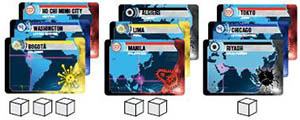
/Use disease cubes matching the card colors.


-
Select Funded Events, Add Them To The Deck, And Deal Out Player Cards
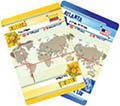
As a group, decide which Funded Event cards are going into the Player Deck. The Player Deck can have as many Funded Event cards as your current funding level. (Your funding level is 4 for your first game).
Shuffle these Event cards and City cards together and deal cards to the players to form their initial hands. Give cards according to the number of players:

In Pandemic Legacy, players keep their hands faceup at all times.
-
Prepare The Player Deck
Divide the remaining player cards into 5 facedown piles, as equal in size as you can. Shuffle 1 Epidemic card into each pile, facedown. Stack these piles to form the Player Deck, placing smaller piles at the bottom.
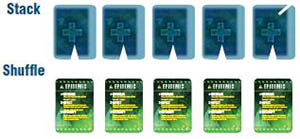
-
Select Characters And Starting Location
Have each player select a character and player color. Give them the corresponding Reference card and pawn. Place their pawns at any one research station. (Players will start their first game in Atlanta). All the characters must start together. Place any remaining character cards and pawns back in the box. If there are no research stations, players start in the ruins of Atlanta.

-

-
Use Game Winning Bonus
Winning a month will result in getting a bonus for the next month played.
The group should use that bonus now. (You won't have a bonus for your first game).
-
Begin Play
Take all the pawns and blindly select one. That player goes first and play proceeds clockwise.
Game Play
Each player turn is divided into 3 steps:
- Do 4 actions.
- Draw 2 Player cards.
- Infect cities.
After a player is done infecting cities, the player on their left goes next.
Players should freely give each other advice. Let everyone offer opinions and ideas. However, the player whose turn it is decides what to do.
Your hand can have City and Event cards in it. City cards are used in some actions and Event cards can be played at any time.
Actions

You may do up to 4 actions each turn.
Select any combination of the actions listed below. You may do the same action several times, each time counting as 1 action. Your character's special abilities may change how an action is done. Some actions involve discarding a card from your hand; all these discards go to the Player Discard Pile.
Movement Actions

Drive / Ferry
Move to a city connected by a white line to the one you are in.

A white line that goes off the board "wraps around" to the other edge and connects to a city.
Example: Sydney and Los Angeles are connected.

Direct Flight
Discard a City card to move to the city named on the card. You cannot use Direct Flight in or out of a city that is rioting, collapsing, or fallen.

Charter Flight
Discard the City card that matches the city you are in to move to any city. You cannot use Charter Flight into or out of a city that is rioting, collapsing, or fallen.

Shuttle Flight
Move from a city with a research station to any other city that has a research station.

Build A Structure

Discard the City card that matches the city you are in to place a structure there. In January, the only structures you have available are research stations; more will come later. Take the structure from the pile next to the board.
If all structures of a type have been built, you may take one from anywhere on the board and move it to your current city. Each city may contain one of each type of structure.
Treat Disease

Remove 1 disease cube from the city you are in, placing it in the cube supply next to the board. If this disease color has been cured (see Discover a Cure below), remove all cubes of that color from the city you are in.
If there are cubes from several cured diseases in a city, you must still Treat Disease once for each cured color to remove these cubes.
If the last cube of a cured disease is removed from the board, this disease is eradicated. Flip its cure marker from its vial side to its "  " side.
" side.
The first time you eradicate a disease, invent a name for it, then write its new name on the board in the disease tracking area. Eradicating a disease also gives you the option to give it a positive mutation at the end of the game as one of your bonuses. Positive mutations may only be applied to diseases that were eradicated in the just-played game.
Eradicating a disease is not needed to win. However, when cities of an eradicated disease are infected, no new disease cubes are placed there. Removing the last cube of a disease that is not cured has no effect.
Share Knowledge

You can do this action in two ways:
give the City card that matches the city you are in to another player, or
take the City card that matches the city you are in from another player.
The other player must also be in the city with you. Both of you need to agree to do this.
If the player who gets the card now has more than 7 cards, that player must immediately discard a card or play an Event card.

Example: If you have the Moscow City card and are with another player in Moscow, you can give this card to that player. Or, if another player has the Moscow card and you both are in Moscow, then you can take it from that player. In either case, you both must agree before handing the card over.
Discover A Cure

At any research station, discard 5 City cards of the same color from your hand to cure the disease of that color. Cover the disease icon (shown at the top of the disease tracking area) with the matching cure marker. If no cubes of this color are on the board, this disease is eradicated. Flip its cure marker to its eradicated side.
If no action is required to Discover a Cure (due to positive mutations) then a player may discard the needed cards from their hand immediately, even if it isn't their turn.
When a disease is cured, its cubes remain on the board and new cubes can still be placed during epidemics or infections. However, treating this disease is now easier.

Draw Cards
After doing 4 actions, draw the top 2 cards together from the Player Deck.

If, as you are about to draw, there are fewer than 2 cards left in the Player Deck, the game ends and your team has lost!
(Do not reshuffle the discard to form a new deck).

Epidemic Cards
If your draws include any Epidemic cards, do not add them to your hand (and do not draw replacement cards for them). Instead, immediately do the following steps in order:
-
Increase: Move the infection rate marker forward 1 space on the Infection Rate Track.
-
Infect: Draw the bottom card from the Infection Deck. Unless its disease color has been eradicated, put 3 disease cubes of that color on the named city. If the city already has cubes of this color, do not add 3 cubes to it. Instead, add just enough cubes so that it has 3 cubes of this color and then an outbreak of this disease occurs in the city. Discard this card to the Infection Discard Pile.

If you cannot place the number of cubes actually needed on the board, because there are not enough cubes of the needed color left in the supply, the game ends and your team has lost! This can occur during an epidemic, an outbreak, or infections (see Outbreaks and Infections below).
-
Intensify: Reshuffle just the cards in the Infection Discard Pile and place them on top of the Infection Deck.

When doing these steps, remember to draw from the bottom of the Infection Deck and to then reshuffle only the Infection Discard Pile, placing it on top of the existing Infection Deck.
It is rare but possible to draw 2 Epidemic cards at once. In this case, do all three steps above once and then again.
In this case, the second epidemic's Infection card will be the only card to "reshuffle", ending on top of the Infection Deck. An outbreak will then occur in this city during Infections (see Infections on page 12), unless an Event card is played to prevent this (see Event Cards on page 15).
After resolving any Epidemic cards, discard them.

Infections
Flip over as many Infection cards from the top of the Infection Deck as the current infection rate. This number is below the space of the Infection Rate Track that has the infection rate marker. Flip these cards over one at a time, infecting the city named on each card.
To infect a city, place 1 disease cube matching its color onto the city, unless this disease has been eradicated. If the city already has 3 cubes of this color, do not place a 4th cube. Instead, an outbreak of this disease occurs in the city. Discard this card to the Infection Discard Pile.
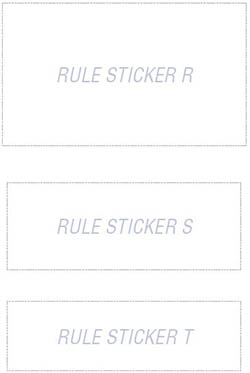
Outreaks
When a disease outbreak occurs, move the outbreaks marker forward 1 space on the Outbreaks Track. Then, place 1 cube of the disease color on every city connected to the city. If any of them already has 3 cubes of the disease color, do not place a 4th cube in those cities. Instead, in each of them, a chain reaction outbreak occurs after the current outbreak is done.
When a chain reaction outbreak occurs, first move the outbreaks marker forward 1 space. Then, place cubes as above, except do not add a cube to cities that have already had an outbreak (or a chain reaction outbreak) as part of resolving the current Infection card.
As a result of outbreaks, a city may have disease cubes of multiple colors on it; up to 3 cubes of each color.

If the outbreaks marker reaches the last space of the Outbreaks Track, the game ends and your team has lost!
Increase Panic Level
Increase the panic level of all cities that have an outbreak. If the game would end due to outbreaks, only increase the panic level for the first 8 outbreaks. If more than 8 cities would outbreak (due to chain reactions) players may choose which cities outbreak and increase their panic level, stopping when you get to the 8th outbreak.
If a city's panic level reaches level 2, remove any research station present in that city. If there is a starting research station sticker in that city, cover that sticker with a destroyed research station sticker.
When an outbreak occurs in a city at panic level 5, do not place a sticker, but resolve the outbreak as usual.
In later games, it is possible for cities to become isolated so that outbreaks in it do not affect any adjacent cities. In this case, increase the panic level of the outbreaking city but do not raise the Outbreaks Track marker.
Check For Scars
Characters standing in an outbreaking city receive a scar.

Turn End
After infecting cities and discarding Infection cards, your turn is over. The player on your left begins their turn.
End of the Game
You win as soon as you meet the necessary number of objectives. The game ends immediately, even if it is the middle of a player's turn or a series of outbreaks.
There are many ways for the game to end and the players to lose:
Immediately when the outbreaks marker reaches the last space of the Outbreaks Track,
Immediately if you are unable to place the number of disease cubes actually needed on the board. Any future cubes and/or outbreaks don't happen,
If a player cannot draw 2 Player cards after doing their actions.

Win Or Lose, The Group Chooses Two Game End Upgrades At The End Of The Game.
IF YOU WIN THE GAME
- You get the Win Bonus for the next month. This is described on cards in the Legacy deck.
- You start your next game at the beginning of the next month.
- Your Funding Level is cut by 2 (minimum of 0) as you clearly have the situation in hand.
- Record your new funding level.
IF YOU LOSE THE GAME
- If this is the first time the month has been played, you must try the month again. If not, move on to the next month for your next game.
- Your Funding Level is increased by 2 (maximum of 10) as this mess needs to be fixed ASAP.
- Record your new funding level.
IN EITHER CASE (WIN OR LOSE)
Choose two upgrades (see next section).
Clear the board of all game pieces.
Discard all City cards. These all reset for the start of the next game. Do not put any Legacy cards back in the Legacy deck, even if playing the same month. Just continue where you left off in the Legacy deck.
If playing the same month again, your mission briefing and objectives are the same.
Game End Upgrades
Win or lose, you choose two upgrades at the end of each game. You may choose the same upgrade twice.
Unfunded Events
Select an event sticker to add to any City card in the Player Deck. This card is now both a City card and an Event card and can be used either way, but not both. These City/Event cards are available every game (they're unaffected by the funding level). Each City card can only have one sticker.
Starting Research Stations
Select a city currently containing a research station and add a starting research station sticker. Add a research station to every city with one of these stickers during the setup of all future games. When placing a starting research station sticker, place it close to the city (similar to the one printed on the board for Atlanta). Do not place it in a panic level sticker box.
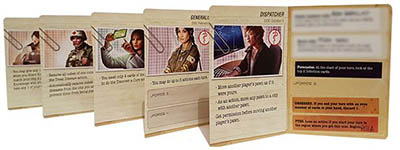
Character Upgrades
Add an upgrade to a character. Each character has room for 2 upgrades (except the Generalist, who has 4). Players may stick an upgrade over an existing upgrade. Upgrades can only be applied to characters that were in the just-played game.
Positive Mutations
If you've eradicated a disease during this game, you may give that disease a positive mutation to make it easier to find a cure in future games. Put the positive mutation sticker on the disease tracking area of the board.
Diseases that gain the Efficient to Sequence mutation are cured as soon as one player discards the necessary number of cards. This does not require an action and can happen on another player's turn.

Cards
Player Cards
As you play, you will have the option to place stickers on City cards. Each City card can have one sticker. When you play a City card with a sticker, you choose whether it is being played as a City card or using the effect of the sticker, never both.
Players may always examine discard piles.
Hand Limit
If you ever have more than 7 cards in hand (after first resolving any Epidemic cards you may have drawn), discard cards or play Event cards until you have 7 cards in hand (see Event Cards).
Only Player cards count towards your hand limit.
Event Cards
Playing an Event card is not an action. The player who plays an Event card decides how it is used. Event cards can be played at any time, except in between drawing and resolving a card.
Example: During infections, the first Infection card drawn causes an outbreak. You may not play the Remote Treatment to prevent this. After this outbreak happens however, you may use Remote Treatment before flipping over the next Infection card.
After playing an Event card, discard it to the Player Discard Pile.
Structures
Each city may contain one of each type of structure.
Research Stations 
You need to be at a research station to use the Discover a Cure action. You can also use the Shuttle Flight action to travel between two research stations. Destroy a research station in a city if it is rioting. If it was a starting research station, replace the starting research station sticker with a destroyed research station sticker. You cannot build a research station in a city that is rioting, collapsing, or fallen.
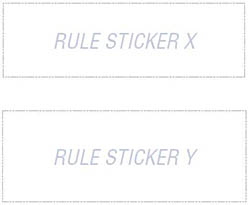
Overlooked Rules
You do not draw a replacement card after drawing an Epidemic card.
You may Discover a Cure at any Research Station - the color of its city does not need to match the disease you are curing.
On your turn, you may take a card from another player, if you are both in the city that matches the card you are taking.
On your turn, you may take any City card from the Researcher (only), if you are both in the same city.
Your hand limit applies immediately after getting a card from another player.
Characters gain a scar from standing in a city that outbreaks.
What Happens If We Mess Up A Rule Since We Can't Go Back?
In most cases, it won't matter. A little rule confusion here or there or a card left out of a deck or something forgotten will not greatly affect your game. Just note it and move on.
In some cases a missing or confused rule will have resulted in a whole game being too easy or too hard. In this case, the group should decide whether to increase their funding for next game (if you accidentally made a game too hard) or reduce funding for the next game (if you made a game too easy).
Game Calendar

If you win, advance to the next month and decrease your funding by 2.
If you lose the first half of the month, play the second half of the month and increase your funding by 2.
If you lose in the second half of the month, increase your funding by 2, then proceed to the next month. Funding cannot go under 0 or over 10.
Continue Reading


